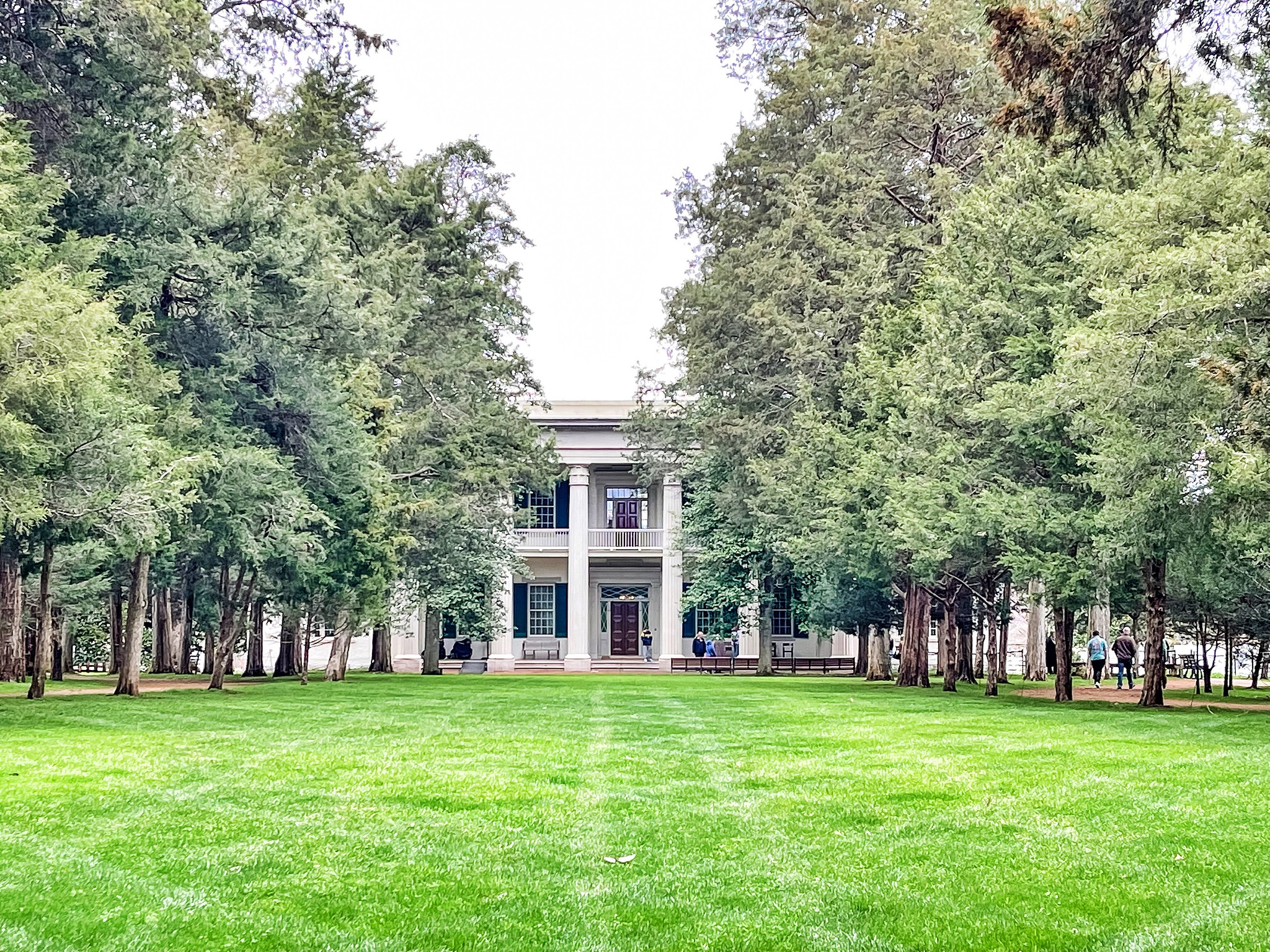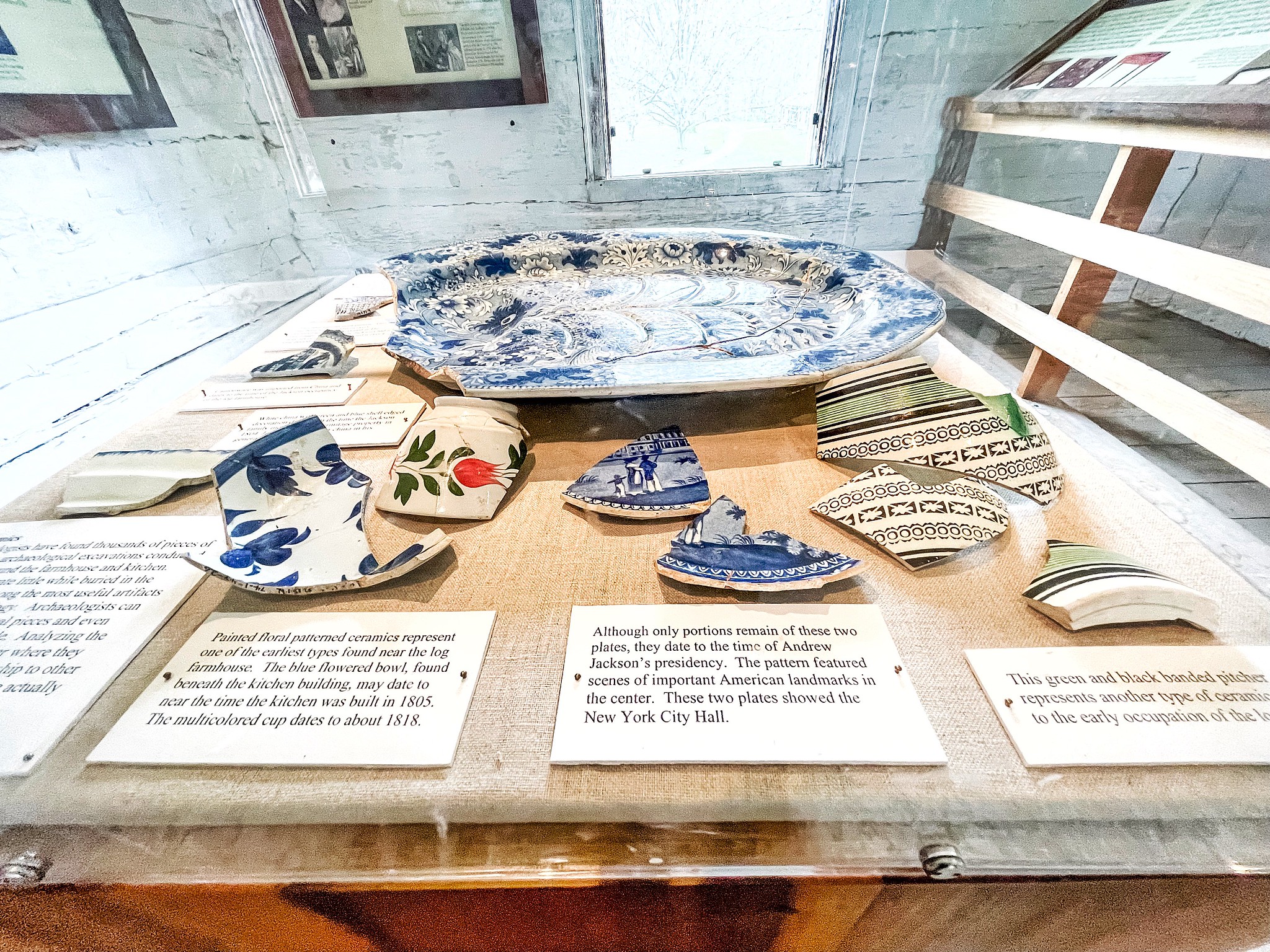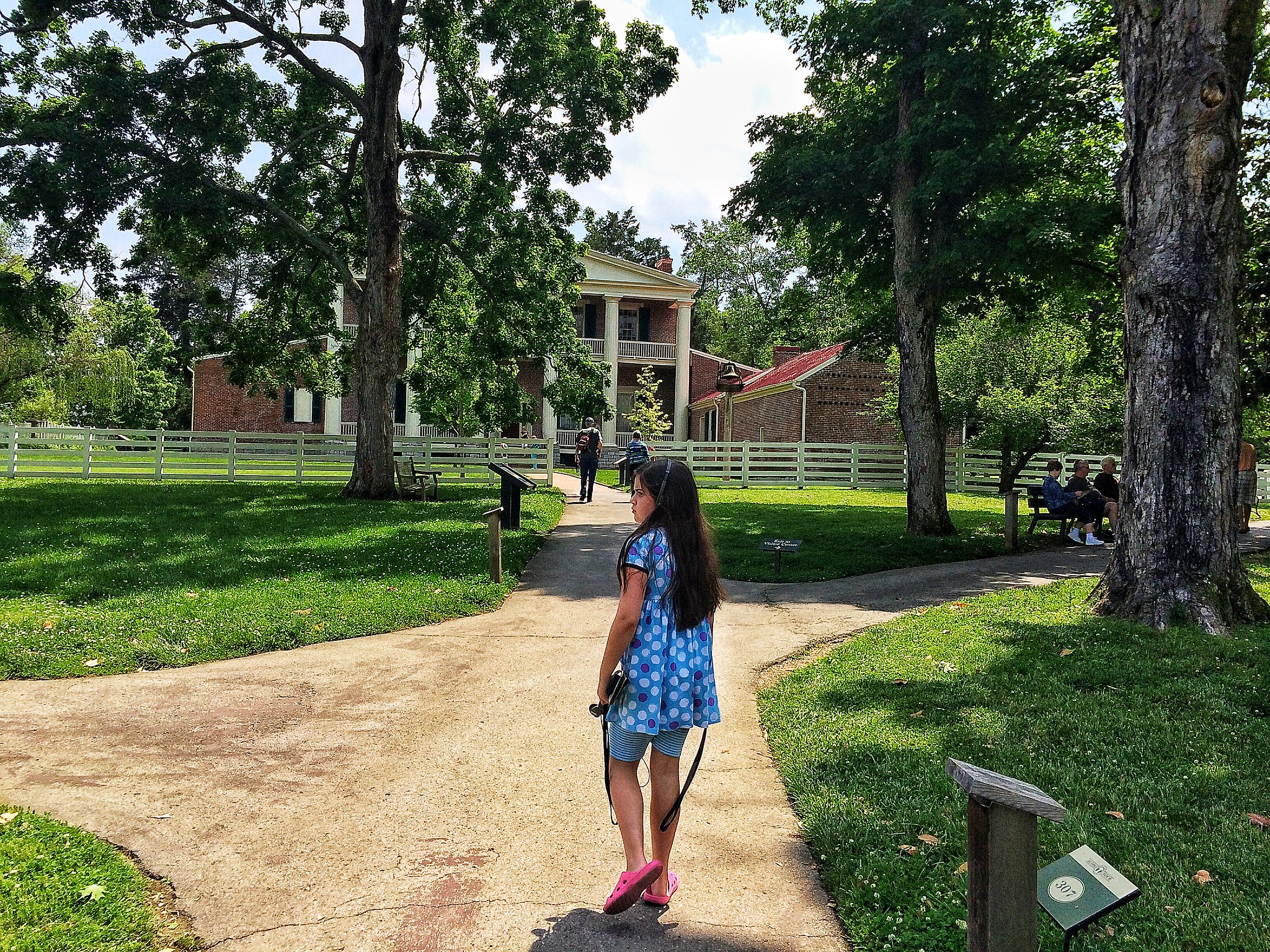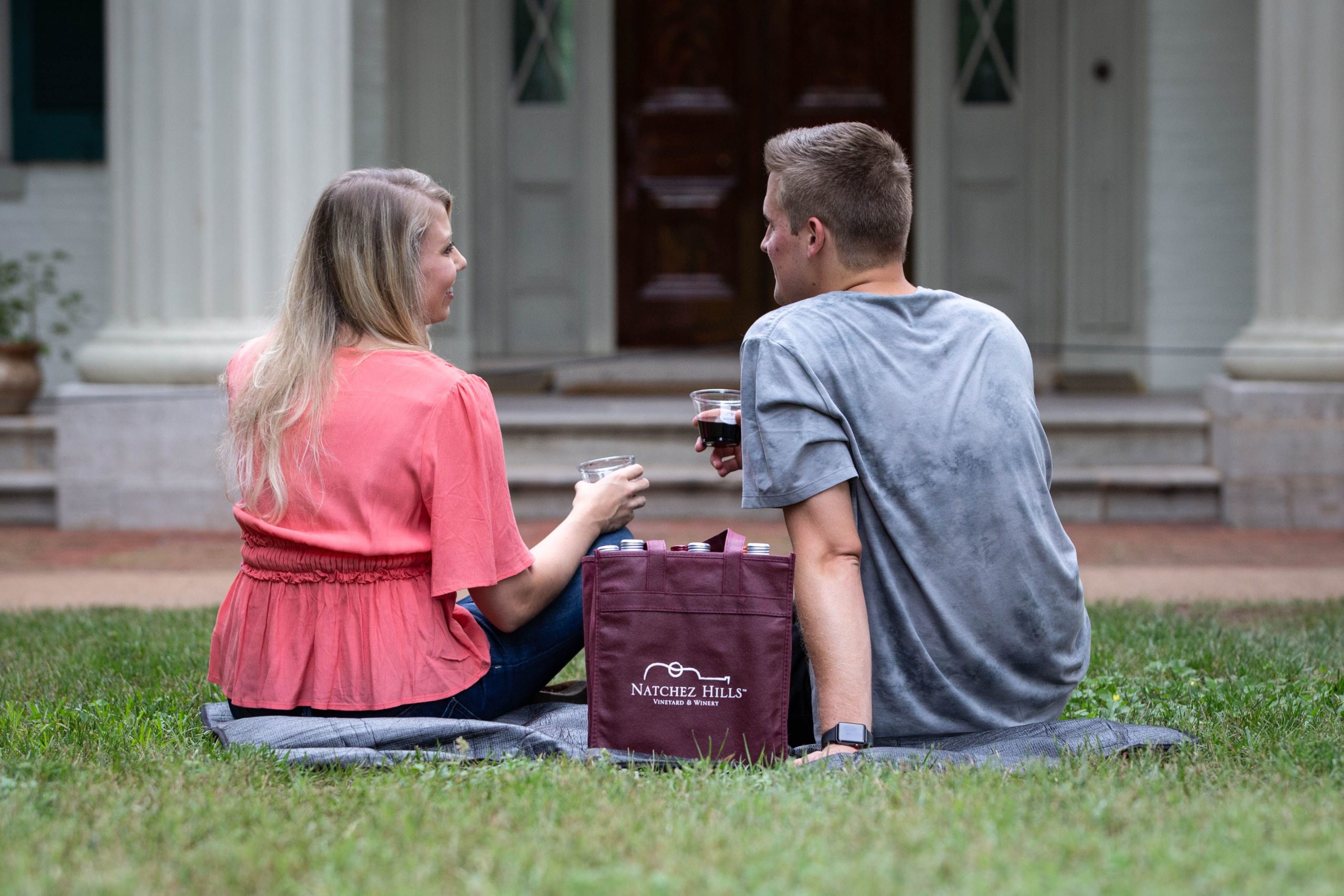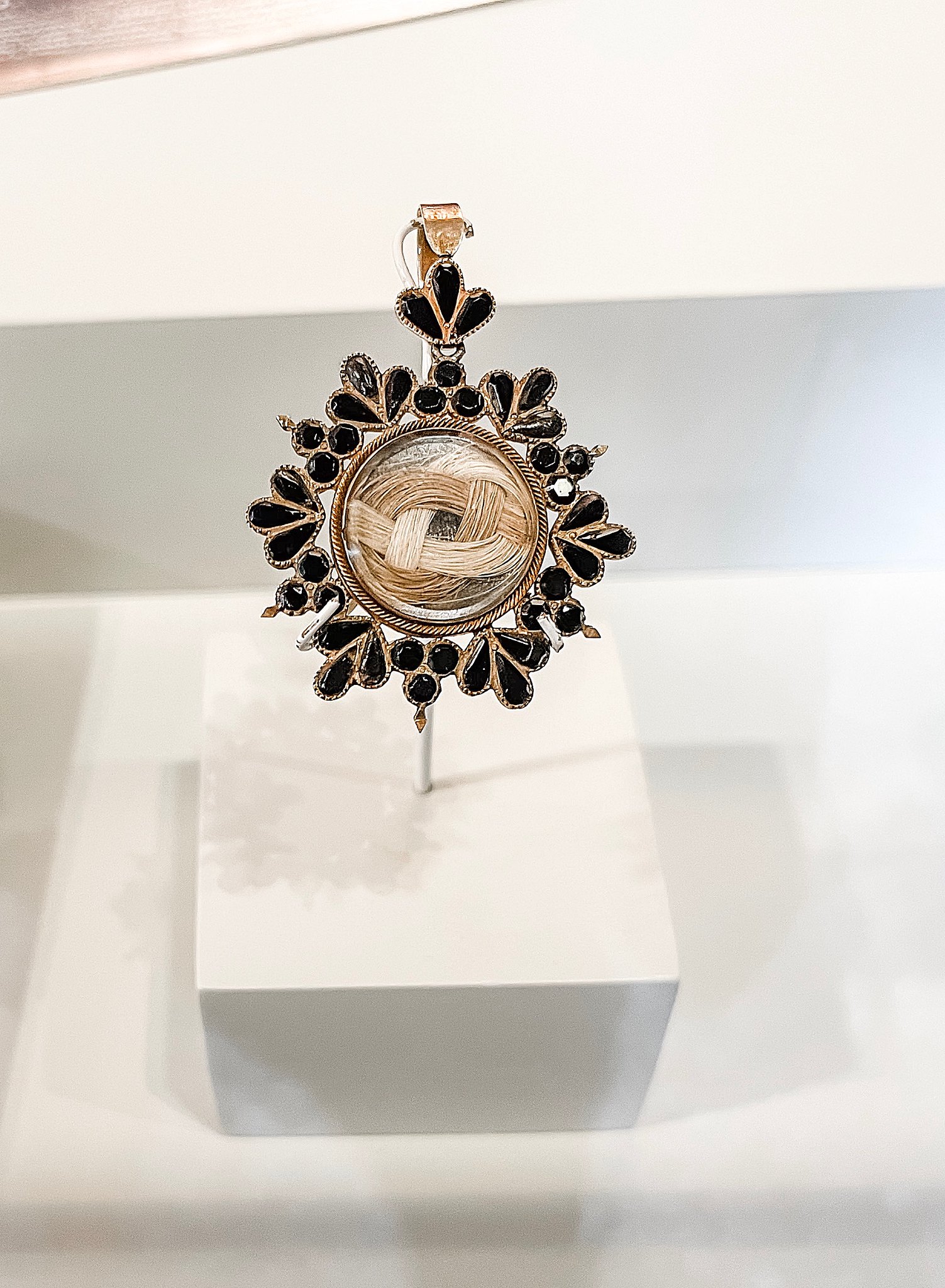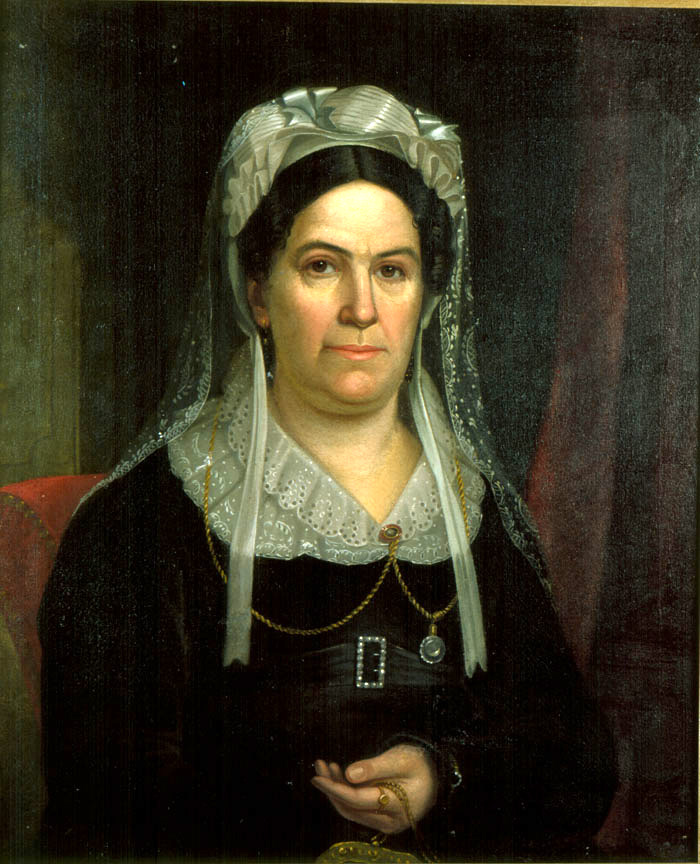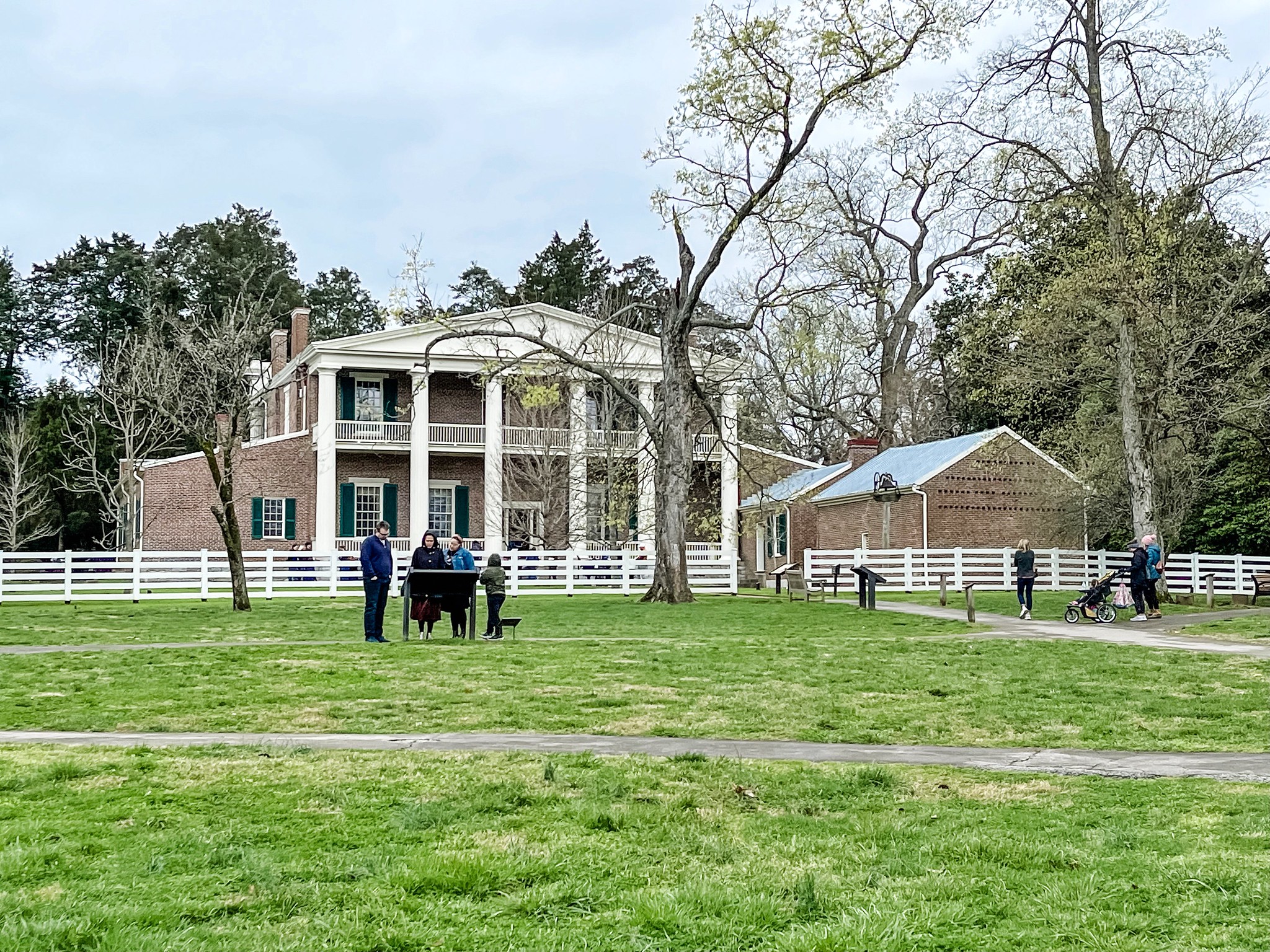contact me
Hi! I'm Lindsay Ferrier. You might remember me from a blog called Suburban Turmoil. Well, a lot has changed since I started that blog in 2005. My kids grew up, I got a divorce, and I finally left the suburbs for the heart of Nashville, where I feel like I truly belong. I have no idea what the future will hold and you know what? I'm okay with that. Thrilled, actually. It was time for something totally different.
Visit Andrew Jackson’s Hermitage and You’ll Discover Some Surprising Secrets
April 20, 2022
Planning to visit The Hermitage in Nashville, Tennessee? Here’s everything you need to know before you go.
A few weeks ago, I had dinner with a group of women, all of whom are fairly new to Nashville.
“I see these historic plantation tours everywhere,” one of them said, “but I always wonder if they’re portraying what happened accurately or if it’s all hoop skirts and Southern gentlemen.”
She had no idea she was talking to someone with an obsession for historic homes and their backstories. I’ve devoured historical novels and narratives about the Civil War era since I was a kid and toured nearly every historic home in Middle Tennessee — in many cases, two or three times.
“That’s an interesting question,” I said, “because when I moved here 20 years ago, the plantation tours I went on on made me feel uncomfortable sometimes, because it seemed like they were really minimizing the role of slavery in plantation life. I would ask questions about it and the tour guides didn’t have much to say.”
“But today,” I continued, “It’s totally different. Slavery is now a big part of every plantation story, and most places even offer specialized tours that focus on the subject. I’ve been really impressed with the changes.”
Nowhere is this shift more evident than at Andrew Jackson’s Hermitage, which seems appropriate given that Jackson is one of the most controversial presidents in our nation’s history. He was beloved by many in his day, first as a war hero committed to protecting the lives of his men, then as the avowed protector of the ‘common man’ as president — the common white man, anyway.
But Jackson was also the owner of more than 150 enslaved men, women, and children and his family’s financial success hinged on their unpaid labor. His signature on the Indian Removal Act in 1830 led to the Trail of Tears — the barbaric displacement of thousands of Cherokee Indians from their homes in the eastern U.S. He had a fiery temper and fought more than a hundred duels in his lifetime. (He only managed to kill one man — He was known to be a terrible marksman.)
So how do you interpret his incredibly well-preserved home and farm for today’s visitors without glorifying a man who did some really horrible things?
You tell the whole story — the good, the bad and the ugly. And that’s exactly what you’ll find on a tour of Andrew Jackson’s Hermitage today. I’ve visited The Hermitage four times now and on each visit, I discover more layers to our seventh president’s complicated story Today, I’m sharing the secrets I’ve learned to getting the most out of a trip to The Hermitage, including hidden spots on the plantation you don’t want to miss, interesting stories and facts that will surprise even repeat visitors, and helpful information you’ll definitely want to know before you go.
Planning the Perfect Visit
A big part of what makes The Hermitage so spectacular from a historical perspective is that it’s been open to the public for tours since 1889 — and since Jackson and his heirs are the only ones who lived on this farm, an impressive amount of original furniture and personal effects have remained on the premises rather than being dispersed among family members or lost to time. And while Jackson’s descendants had to sell off portions of the property over the years to pay off debts, over time, the Andrew Jackson Foundation has managed to buy back all but 50 acres of Jackson’s original 1,000 acre plantation.
And there’s more! A multi-million dollar restoration project in the 1990s used newly-available technology to help return the mansion as much as possible to what it looked like when Jackson retired there after his presidency. Paint chips were analyzed. Letters and documents and photographs were studied. Original wallpaper was recovered and reprinted.
Outside the house, multiple archaeological excavations have uncovered more than one million artifacts from the enslaved community that lived in cabins built around the mansion. This has allowed experts to interpret the lives of the enslaved here with much greater thoroughness and accuracy than would be possible on other historic sites, resulting in a more nuanced interpretation of the complex relationships between the Jacksons and their enslaved workers. And all of this background information leads to my very first secret:
The house tour is only part of what makes The Hermitage great.
Yes, the house is amazing, and there is much to see inside. That said, the tour is fairly short and you aren’t allowed to actually go inside any of the rooms — For preservation’s sake, you’ll have to content yourself with gazing at them from the hallways. But while the house always fascinates me, I find I learn the most outside the mansion.
My advice? Start your visit at the Andrew Jackson Welcome Center, where museum exhibits and a 20-minute movie will introduce you to the life and accomplishments of Andrew Jackson. (FYI, while most adults will enjoy the film, I think it’s too dry for kids.) Next, take the 20-minute house tour. And finally, allow plenty of time to tour the grounds. Dress for the weather because you’ll be out in it for quite some time and pay close attention to my next secret, which in my opinion is the best part of the Hermitage experience.
The audio tour is a must.
Several audio tours for adults and children are included in the cost of your ticket — You can choose a tour (or tours!) based on your specific interests. The audio tours are accessed with a QR code on your phone, so I highly recommend that you bring headphones or earbuds with you. The quality of these tours is absolutely fantastic, with actors portraying various Hermitage residents, background music and sound effects, and historical photos that appear on your phone’s screen to enhance the experience. My daughter listened to the kids’ tour on a visit here when she was eleven and absolutely loved it — I still remember that day as one of her best ‘living history’ lessons ever.
Don’t skip the Nature Trail.
The grounds include a gorgeous garden where you’ll find Jackson’s tomb, original slave cabins, the kitchen and smokehouse, and more, but one of my favorite things to do here is take a walk on the Nature Trail. The 1.5 mile loop trail starts at the springhouse, winds through a forest and alongside a spring-fed creek, and leads out to the field quarter, where you’ll find the excavated foundations of the cabins once built for the enslaved workers who toiled in Jackson’s cotton fields. Interpretive boards along the path explain the information archaeologists have discovered about this population, and what they’ve learned about their story is very illuminating. (You can read more about it below.) As you loop back into the woods, you’ll pass a cotton field that The Hermitage still maintains today. It’s an easy and informative walk that takes you away from the crowds of tourists and I highly recommend it.
These cool Hermitage features need to be on your radar.
Did you know The Hermitage is also home to a meat & three soul food restaurant? I didn’t! It’s called Bailey & Cato and it’s a great way for visitors to experience traditional Southern dishes like catfish, oxtails, and turnip greens. Bailey & Cato is open from 11am-4pm Thursday through Monday.
Your ticket includes a discounted wine tasting inside the Natchez Hills Winery tasting room at The Hermitage. Wine flights, wine by the glass, wine by the bottle and wine slushes are all available for guests, as well as local craft beer on tap. And you’re free to enjoy your drink on the grounds — No need to chug it in the tasting room!
The Hermitage also offers VIP tours at 10am and 2pm each day. This 90-minute tour led by a costumed interpreter is $50 per ticket and it’s now on my bucket list. It’s a great way to get an in-depth look at the life and legacy of Andrew Jackson and the people who surrounded him. Another private tour option on my bucket list is called In Their Footsteps. It’s about the lives of the enslaved men and women who lived at The Hermitage, it’s $45 per ticket, and it takes place at 1pm each day. You’ll want to reserve your spot on these tours ahead of time, because they fill up quickly.
If you have kids, consider The Hermitage Enslaved: A Wagon Tour. A horse-drawn wagon will take you to the field quarter, where your guide will tell you how this population lived and worked in the 1800s. The tour takes 30 minutes and is $15 per ticket. Children five and under ride free.
Interesting Facts to make your Hermitage Visit Even Better
I’m big on researching historic sites before I visit them — Knowing the backstory makes the visit a whole lot more fun, plus I can annoy my family with tons of facts and try to outsmart the tour guide! Yes, I am that person you try to get away from at cocktail parties.
Anyway, now’s the time that you get to reap the spoils of my labor. Here are a few fascinating stories that should add even more enjoyment to your trip to Andrew Jackson’s Hermitage.
We need to talk about Rachel
We tend to think of people who lived 200 years ago as very buttoned-up and proper by today’s standards, but I’m here to tell you these people were just as messed up as we are today — Maybe, more so. Case in point: Rachel Jackson. Or, more specifically, Rachel Donelson Robards Jackson.
Rachel married a man named Lewis Robards when she was 18, but he was a total jerk and the marriage was not a happy one. She went to live with her widowed mother, who was running a boarding house. Andrew Jackson just happened to be one of the boarders there, and the two fell in love. When Robards came for a visit, he deduced that Rachel had a new love interest, and rather than dueling with Andrew (A duel? Why am I not surprised?), he went off to get a divorce.
Believing she was single again, Rachel married Andrew in 1791 in Natchez, but when the couple returned to Nashville, they learned that Rachel’s divorce hadn’t actually been finalized. Yup. Rachel was married to two men. After hearing the news, Robards added ‘bigamy’ to his petition and his divorce became official. Andrew and Rachel married for realsies in Nashville in 1794. The end, right?
Um. No.
Bigamy didn’t go over so well in polite society and Andrew Jackson had plenty of enemies who were more than happy to bring up his wife’s dubious history. Many of those 103 duels Andrew Jackson fought during his lifetime were in defense of his wife’s honor, and when he ran for president, his critics had a field day with the gossip, calling Rachel a bigamist and a fallen woman. Rachel was devastated and terrified at the prospect of living among the Grade-A gossips in Washington, D.C. She died of what was probably heart failure at The Hermitage just a few weeks before her husband took office. Jackson told friends and family members that his wife died of a broken heart.
For all his faults, it’s clear Andrew really loved his wife. He never married again. He kept a small portrait of her on his person at all times. He also commissioned a larger portrait of Rachel and hung it over the mantel in his bedroom, first at the White House and then at The Hermitage, so that Rachel would be the first person he saw in the morning and the last person he saw at night. The portrait still hangs in the same spot at The Hermitage today.
Jackson had a lovely tomb built for Rachel in the garden outside the mansion, which he visited every day once he’d moved back home from Washington. He would later be buried there beside her. The inscription on her grave reads: ‘A being so gentle and virtuous, slander might wound but could not dishonor. Even death when he took her from the arms of her husband could but transport her to the bosom of her God.’
It makes me want to cry a little just thinking about it.

Source: Bradley Howington/Pexels
Poll the Parrot
Let’s lighten the mood a bit, shall we? Rachel had a parrot named Poll, which spoke phrases in Spanish and English, as well as several curse words. Before her funeral, the bird was on the porch and became agitated by all the mourners. It started cursing loudly during the service and had to be taken away. One observer remembered, “People were horrified and awed by the bird’s lack of reverance.” I can only imagine.
Incidentally, Poll the parrot is the narrator of the children’s audio tours at The Hermitage. Poll doesn’t curse during the tours, though. I promise.
Slavery at The Hermitage was every bit as complicated and disturbing as you’d imagine.
Although slavery is now included in the stories of historic Southern homes and plantations I’ve visited, most tour guides still seem hesitant to talk about how unhappy the enslaved workers must have been with their situation. This is not the case at The Hermitage. It’s easy to see here that the relationship between the Jackson family and their enslaved workers was problematic.
It seemed important to Andrew Jackson and his family to give visitors the impression that their enslaved workers were treated well. They referred to them as their ‘black family’ and allowed them to marry and live in family units. Archaeological evidence suggests that enslaved people at The Hermitage had spending money, toys, and decent china, and that at least some of them had been taught to read, write, and do math. There are also letters from Jackson to his overseers, admonishing them to treat his enslaved workers well, let them rest when sick, and not work them too hard.
And yet…
Jackson was also writing letters like this one to his nephew, in 1821:
Mrs. Jackson informs me that her maid Betty has been putting on some airs, and has been guilty of a great deal of impudence. {I} have directed that the first impertinence she uses, or the first disobedience of orders, that she be publicly whipped. She can behave herself if she will and I have told her that Publickly whipped she shall be, the first offence.
Publicly whipped for ‘putting on airs?’ Wow. I thought about this letter for a long time after I read it.
Archaeologists also believe that at least some of the enslaved people at The Hermitage secretly still followed African Bakongo religious practices. They found coins with holes in them, strange bones, and marbles with a cross symbol carved into them that support this theory. You can see photographs of these artifacts if you take the Nature Trail to the Field Quarter.
After Jackson’s death in 1845, It’s very telling that when the Union took over Nashville during the Civil War, most of the enslaved people at The Hermitage fled there rather than remaining on the plantation, including their most trusted worker, Hannah, and her daughters. Check out this excerpt from a letter Jackson’s daughter-in-law wrote to her husband in 1863:
I fear all our servants will leave us. Nancy, Hannah, Martha and her three children are all gone. We have nothing but black looks from all of them they are very unwilling to do any work — it is with difficulty we can get anything out of them. Drs. Joe Smith Left a day or two ago, he is looking daily for others to go. Affairs are in a deplorable situation here.
Knowing this context adds more understanding to the stories you’ll learn about the enslaved men, women, and children at The Hermitage during your visit.
The best wallpaper story you’ll ever read.
You’ll see all kinds of interesting items during the house tour, but the most striking feature of the home for me was the identical sets of wallpaper in the upstairs and downstairs entry halls. Chosen by Rachel Jackson and ordered from Paris, it tells the story of Telemachus, from The Odyssey, and it is absolutely stunning. Fire destroyed the original paper upstairs several years after it was installed, and it wasn’t until the 1990s that The Hermitage, working with The Louvre in Paris, was able to secure identical wallpaper from a 200-year-old chateau in France. Painstakingly removed, restored by experts, and installed at The Hermitage in 1996, the upstairs wallpaper is probably older than the house itself!
There’s more to the Garden than first meets the eye.
The garden was one of Rachel Jackson’s favorite spots and it’s particularly beautiful in the spring, but little is known about what was grown there during the Jacksons’ time. Today, gardeners have filled the space with flowers and plants that would have been popular in Middle Tennessee in the 19th century. Both Rachel and Andrew are buried here, as well as several family members and former enslaved worker Alfred Jackson, who lived at The Hermitage longer than any other person — He even gave tours here for a time until his death in his cabin at The Hermitage in 1901. You can learn more about Alfred’s life here.
This post is a long one, but it contains only a fraction of the fascinating things I’ve discovered at The Hermitage during my visits there. You’ll just have to see the place for yourself — and I recommend setting aside plenty of time during your visit to explore. You could easily spend half a day here learning about the lives of those who stood on this ground two centuries ago. It’s a story that will stay with you for years to come.
Do you have questions or comments about this post? Contact me. I’d love to hear from you! And to keep up with all our adventures in Nashville and beyond, follow me on Facebook, Instagram, Pinterest, and Twitter.
Leave a Reply Cancel reply
This site uses Akismet to reduce spam. Learn how your comment data is processed.
